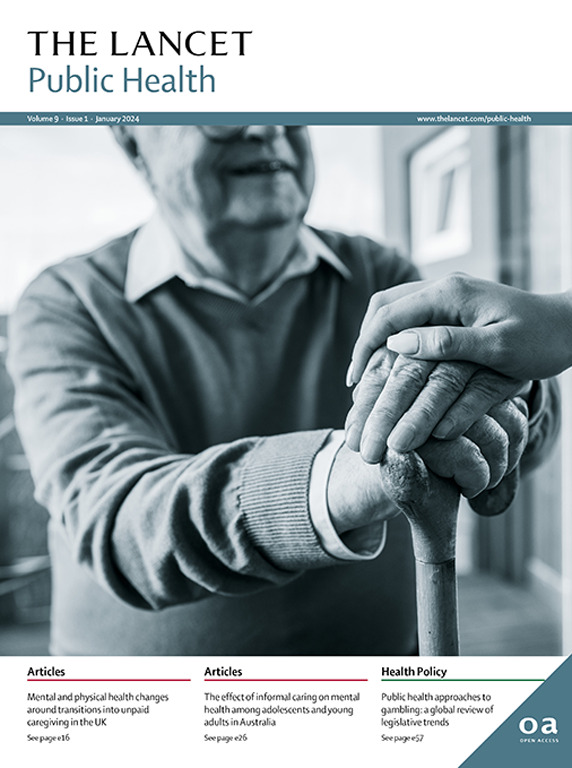外来务工人员的工作场所死亡风险和社会决定因素:系统回顾和荟萃分析
IF 25.2
1区 医学
Q1 PUBLIC, ENVIRONMENTAL & OCCUPATIONAL HEALTH
引用次数: 0
摘要
背景农民工有 1.7 亿人,他们经常在危险或不健康的工作环境中工作,很可能遭受工伤和劳动侵害。然而,与本地工人相比,外来务工人员的死亡风险尚不清楚。我们旨在综合有关外来务工人员死亡风险的全球证据,并确定社会决定因素,为外来务工人员的健康和安全保护提供依据。方法我们对同行评议的文献进行了系统回顾和荟萃分析,以研究外来务工人员的死亡结果及相关风险因素。我们检索了 MEDLINE、Embase、PsycINFO 和 Ovid Global Health 中发表于 2000 年 1 月 1 日至 2023 年 1 月 17 日之间、用英语报告定量初步研究的研究。对移民工人采用了广义的定义,包括任何在国外出生的工人(即国际第一代移民工人),无论是从事有偿工作还是自营职业。国内移民、第二代移民和外国医护人员不包括在内。主要结果是任何报告的死亡率,包括全因死亡率、特定原因死亡率、自杀、他杀和致命工伤。我们使用荟萃分析来比较外来务工人员和本地务工人员的结果,并使用随机效应模型来计算汇总估计值。我们使用叙事综合法建立了一个数据驱动的概念框架,该框架捕捉了外来务工人员死亡率的交叉性社会决定因素。研究方案已在 PROSPERO 上注册,注册号为 CRD42023372893。研究结果在 11 495 项已识别记录中,44 项被纳入系统综述,其中 11 项研究被汇总到荟萃分析中。数据来自 16 个国家,其中大部分是高收入国家,包括 44 338 例移徙工人死亡病例,其中包括来自农业、建筑业、采矿业和服务业的移徙工人。与本地工人相比,外来务工人员发生致命工伤的风险较高(汇总相对风险为1-71,95% CI为1-22-2-38;8项研究;I2=99-4%),而全因死亡的风险较低(0-94,0-88-0-99;3项研究,I2=90-7%)。与本地工人相比,外来务工人员更有可能死于外部死因(如跌倒或袭击),而非内部死因(如呼吸系统或消化系统疾病),外来务工人员也更有可能死于与工作有关的凶杀,尤其是在零售业和性行业,有证据表明,与本地女工相比,外来女工的自杀率更高。造成不良死亡结果的影响性社会决定因素包括与移民相关的因素(如较低的语言能力、无证身份和较长的逗留时间)和与劳工相关的因素(如不稳定的就业、劳工移民政策和放松经济管制政策)。这种健康方面的不公平现象亟需通过未来的干预措施加以解决,这些干预措施应在结构层面上考虑到与移民和劳动力相关的健康社会决定因素,如将劳动保护法扩展至移民工人,并改善这一重要且不断增长的劳动力的职业健康、安全和工作场所条件。本文章由计算机程序翻译,如有差异,请以英文原文为准。
Workplace mortality risk and social determinants among migrant workers: a systematic review and meta-analysis
Background
Migrant workers, a population of 170 million, often work in dangerous or unhealthy working environments and are likely to suffer workplace injuries and labour abuses. However, the risk of mortality in migrant workers compared with local workers is unknown. We aim to synthesise global evidence on migrant worker mortality risk and identify social determinants to inform health and safety protections for migrant workers.Methods
We conducted a systematic review and meta-analysis of peer-reviewed literature to examine mortality outcomes among migrant workers and associated risk factors. We searched MEDLINE, Embase, PsycINFO, and Ovid Global Health for studies published between Jan 1, 2000, and Jan 17, 2023, reporting quantitative primary research in English. A broad definition of migrant worker was used, including any worker who is foreign-born (ie, international first-generation migrant workers), either in paid employment or self-employment. Internal migrants, second-generation migrants, and foreign health-care workers were excluded. The primary outcome was any reported mortality, including all-cause mortality, cause-specific mortality, suicide, homicide, and fatal occupational injury. We used meta-analysis to compare outcomes between migrant worker and local worker populations, and a random-effects model to calculate pooled estimates. We used narrative synthesis to develop a data-driven conceptual framework capturing the intersectional social determinants of mortality in migrant workers. The study protocol is registered on PROSPERO, CRD42023372893.Findings
Of 11 495 identified records, 44 were included in the systematic review, of which 11 studies were pooled in meta-analyses. Data were from 16 countries, most of which were high-income countries, and included 44 338 migrant worker deaths, including migrants from the agriculture, construction, mining, and service industries. Compared with local workers, migrant workers had a higher risk of fatal occupational injury (pooled relative risk 1·71, 95% CI 1·22–2·38; eight studies; I2=99·4%), and a lower risk of all-cause mortality (0·94, 0·88–0·99; three studies, I2=90·7%). Migrant workers were more likely to die from external causes of death (such as falls or assaults) than internal causes of death (such as respiratory or digestive diseases) compared with local workers, with migrant workers also more likely to die from work-related homicides, especially in the retail and sex industries, with some evidence of higher suicide rates among female migrant workers compared with female local workers. Influential social determinants for poor fatality outcomes include migration-related factors (such as lower language proficiency, undocumented status, and long duration of stay) and labour-related factors (such as precarious employment, labour migration policies, and economic deregulation policies).Interpretation
Migrant workers have a higher risk of workplace fatal injury despite being generally healthier than local workers, which could be explained by structural determinants such as precarious employment and inadequate safety protection. This health inequity must be urgently addressed through future interventions that account for migration-related and labour-related social determinants of health at the structural level, such as extending labour protection laws to migrant workers, and improving occupational health and safety and workplace conditions for this vital and growing workforce.Funding
UK Medical Research Council and National Institute for Health and Care Research.求助全文
通过发布文献求助,成功后即可免费获取论文全文。
去求助
来源期刊

Lancet Public Health
Medicine-Public Health, Environmental and Occupational Health
CiteScore
55.60
自引率
0.80%
发文量
305
审稿时长
8 weeks
期刊介绍:
The Lancet Public Health is committed to tackling the most pressing issues across all aspects of public health. We have a strong commitment to using science to improve health equity and social justice. In line with the values and vision of The Lancet, we take a broad and inclusive approach to public health and are interested in interdisciplinary research.
We publish a range of content types that can advance public health policies and outcomes. These include Articles, Review, Comment, and Correspondence. Learn more about the types of papers we publish.
 求助内容:
求助内容: 应助结果提醒方式:
应助结果提醒方式:


